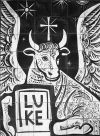
Two Sabbath Controversies: Lk 6,1-11
Luke has brought the two Sabbath incidents together by referring to "another sabbath" in 6,6. This makes a connection with the sabbath of 6,1. In Mark (Mk 3,1) the second sabbath story begins with a clearer break and there is no immediate mention of the sabbath.
Eating on the Sabbath: 6,1-5
The Hebrew word "torah" is closer to the English word "teaching" than to "law". Yet teachings easily become laws especially as they have to be adapted to new circumstances. Deuteronomy (Dt 23,25) does allow gleaning of corn heads by passers-by. The problem is that the disciples are doing this on the sabbath and so are working. This is emphasised by Luke who notes that the disciples were rubbing the corn in their hands. At issue is the sabbath rest in the ten commandments (Dt 5,12-15). Gleaning the corn was work in the eyes of the Pharisees and thus the disciples were breaking the law.
Jesus comes to the defence of his disciples. He has a broader vision, taking as his example David and his men eating bread reserved for priests (Lev 24,5-9) as told in 1 Samuel 21,1-6. The implied parallel between Jesus and his disciples and David and his companions is itself provocative.
In verse 4 Luke then adds to Mark the work "take". This gives us a comparison with the same actions at the last supper: take, give thanks, breaks, gives (22,19).
Luke omits the saying in Mark 2,27 and so he stresses the authority of Jesus with just the statement that the Son of Man is Lord of the Sabbath (6,5)
Healing on the sabbath: 6,6-11
This time, the scribes and Pharisees say nothing in response to Jesus' challenge. Yet in seeking an accusation against Jesus, they are already anticipating the trial at the end of the Gospel story (23,2).
Luke though stresses that Jesus knew their thoughts (6,8, see also 5,22). This is characteristic of a prophet (7,39).
As with the healing of Simon's Mother in Law (4,38-39), there is resurrection language in this verse with the man being told to rise.
Thus Jesus again shifts the question from legal requirements to real needs. Verse 9 is the climax of both incidents and maybe of the whole section 5,12-6,11. Jesus makes it very plain that he welcomes all, especially those needing healing and forgiveness. He has called disciples, but he has made an unlikely choice of men by human standards. This will become even clearer in the verses which follow (6,12-16).
The healing in verse 10 is a simple command, a notable contrast to the strong language of Mk 3,5. Yet no work is done, Jesus does not even touch the man as he did previously with the leper, 5,13.
6,11 is milder than Mk 3,6 because there is no plotting mentioned. Yet Luke's comment is stronger because the Pharisees are furious (literally: "filled with senselessness").
Thus there is now a breakdown of relations between Jesus and the Pharisees. We return to the main page so as to find out what happens next.
